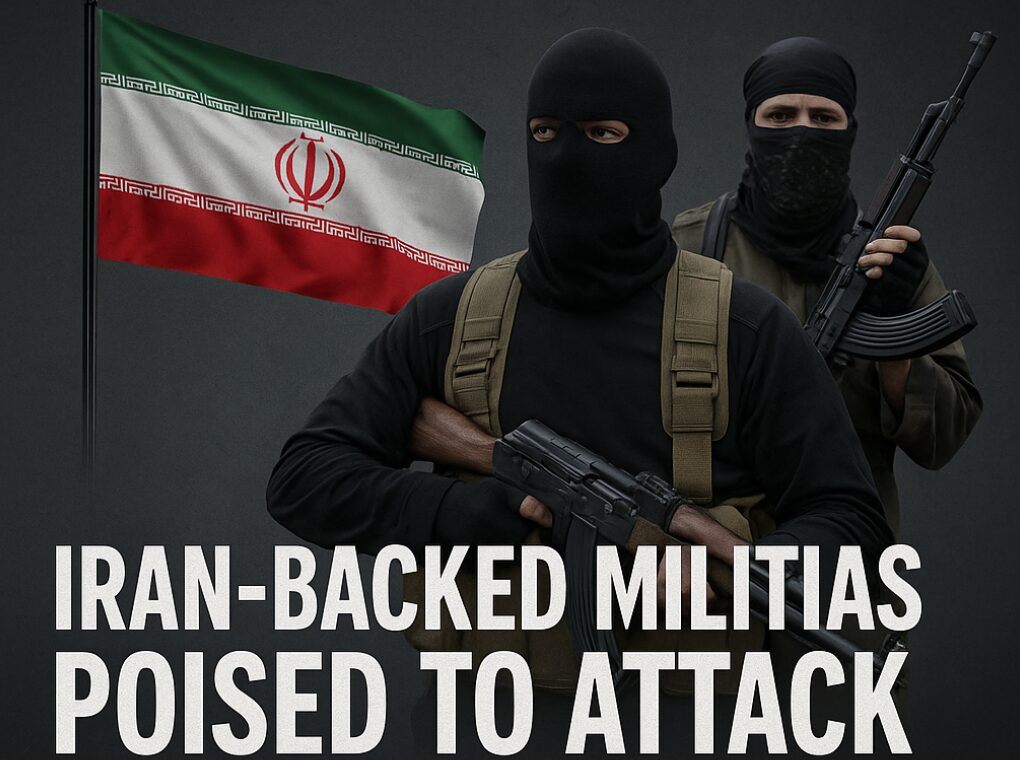Iran-backed militias are actively preparing to launch strikes against U.S. military installations in Iraq, while intelligence officials now warn that Tehran has activated a broader network of proxy forces and sleeper cells targeting American interests across the Middle East—and potentially within the United States itself.
According to a New York Times report confirmed by multiple defense sources, U.S. intelligence has tracked movements by Kata’ib Hezbollah, Asa’ib Ahl al-Haq, and other pro-Iranian factions in Iraq, suggesting imminent coordinated attacks on American troops. These developments come just days after the controversial U.S. airstrikes on Iranian nuclear facilities under “Operation Midnight Hammer,” which have pushed the region into a new phase of confrontation.
U.S. Troops in the Crosshairs
Currently, 40,000 to 50,000 U.S. troops are stationed across at least 19 active military sites throughout the Middle East—including key installations in Iraq, Kuwait, Qatar, Bahrain, and Syria. The Pentagon has elevated threat levels across multiple locations, deploying additional air defense systems and scrambling intelligence drones to monitor unusual movements around bases like Al-Asad and Erbil.
A senior U.S. defense official said:
“We are now looking at a multi-theater threat. This is no longer just about Iraq or even just the Middle East—it’s a global counterintelligence challenge.”
Proxy Activation: Yemen, Syria, Lebanon—and Beyond
Iran’s powerful Quds Force, the elite external operations arm of the Islamic Revolutionary Guard Corps (IRGC), has reportedly issued activation orders to aligned groups in:
Yemen (Houthis): Preparing long-range drone and missile launches against U.S. and Israeli targets.
Syria and Iraq: Mobilizing Shiite militias to target U.S. convoys and embassies.
Lebanon (Hezbollah): Ramping up activity on Israel’s northern border and possibly preparing for asymmetric attacks in Cyprus or the Mediterranean.
Gaza and the West Bank: Encouraging coordinated unrest to stretch Israeli resources thin.
Homeland Alert: Sleeper Cell Threats Inside the U.S.
In a concerning development, U.S. law enforcement and homeland security agencies have raised internal alert levels amid chatter that Iran may activate sleeper cells or lone-wolf sympathizers inside the United States. While no specific attack plans have been confirmed, intelligence officials point to past IRGC-Quds Force plots, including the 2011 attempted assassination of the Saudi ambassador in Washington, as a reminder that Tehran’s reach extends beyond the region.
A Homeland Security bulletin circulated on June 22 warns of:
“Increased likelihood of influence operations and targeted acts of violence on U.S. soil by individuals aligned ideologically or operationally with the Iranian regime.”
FBI field offices in New York, Washington D.C., and Los Angeles have reportedly been briefed on the elevated threat level.
Russia-Iran Axis and the Global Fallout
Complicating matters is the growing Russia-Iran strategic alignment. With Russia still bogged down in its war in Ukraine and under heavy Western sanctions, Moscow has thrown vocal support behind Tehran, denouncing U.S. actions and hinting at nuclear consequences. Former Russian President Dmitry Medvedev recently warned that “multiple nations” may consider arming Iran with nuclear weapons in response to American aggression.
This signals a dangerous widening of global fault lines, as Russia seeks to offset its own strategic overextension by leveraging Iran as a destabilizing partner in the Middle East.
U.S. Political Debate and Strategic Dilemma
At home, the Trump administration faces criticism from both hawks and doves. Critics warn that the strikes on Iran may have been tactically precise but strategically reckless, while supporters argue they were necessary to uphold nonproliferation red lines.
U.S. forces now find themselves caught in an escalating storm—where dormant threats are reawakening, and Iran’s vast hybrid warfare apparatus is shifting into action across multiple domains: cyber, kinetic, and covert.
The Risk of a Multi-Front Conflagration
From Baghdad to Beirut—and potentially from the Red Sea to the U.S. homeland—the activation of Iran’s proxy network marks a dangerous turning point. With both American and allied interests now under threat, and with Iran signaling it will respond “anytime, anywhere,” the Middle East could be lurching toward a broader regional war—one with direct consequences for the U.S. and its allies far beyond the battlefield.
